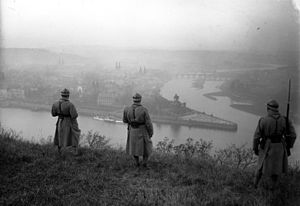
Back احتلال راينلاند Arabic Reynlandın işğalı Azerbaijani Акупацыя Рэйнскай вобласці Byelorussian Okupace Porýní Czech Alliierte Rheinlandbesetzung German Renaniaren okupazioa Basque Reininmaan miehitys Finnish Occupation de la Rhénanie après la Première Guerre mondiale French כיבוש חבל הריין HE Pendudukan Rheinland oleh Sekutu ID
 French soldiers at Ehrenbreitstein Fortress watching over the Deutsches Eck, 1929 | |
| Date | 1 December 1918 – 30 June 1930 |
|---|---|
| Duration | 11 years, 6 months, 4 weeks and 1 day |
| Location | Left Bank of the Rhine, Germany |
| Coordinates | 50°21′26.7″N 7°36′07.0″E / 50.357417°N 7.601944°E |
The Occupation of the Rhineland placed the region of Germany west of the Rhine river and four bridgeheads to its east under the control of the victorious Allies of World War I from 1 December 1918 until 30 June 1930. The occupation was imposed and regulated by articles in the Armistice of 11 November 1918, the Treaty of Versailles and the parallel agreement on the Rhineland occupation signed at the same time as the Versailles Treaty.[1] The Rhineland was demilitarised, as was an area stretching fifty kilometres east of the Rhine, and put under the control of the Inter-Allied Rhineland High Commission, which was led by a French commissioner and had one member each from Belgium, Great Britain and the United States (the latter in an observer role only). The purpose of the occupation was to give France and Belgium security against any future German attack and serve as a guarantee for Germany's reparations obligations. After Germany fell behind on its payments in 1922, the occupation was expanded to include the industrial Ruhr valley from 1923 to 1925.
In the early years of the occupation, a number of separatist movements – some supported by the French – attempted to create an independent Rhineland allied to France, but none of them had significant popular support. Relations between the occupying forces and the German residents were often strained, although more so in the French and Belgian zones than in the American and British. Both the French and the Germans engaged in major propaganda campaigns, the French to try to win the Rhinelanders over to their side and the Germans to rouse national and international feelings against the occupation. The German propaganda war included racist attacks against black French colonial troops.
Following the signing of the Locarno Treaties that settled Germany's western border in late 1925, the northern occupation zone around Cologne was evacuated in January 1926. The Koblenz region, which the Americans had handed over to the French in 1923, was evacuated in November 1929. After a "final" agreement on reparations was reached in the 1929 Young Plan, the occupation of the Rhineland ended on 30 June 1930, five years earlier than originally set down in the Treaty of Versailles.

blue: France, now including the former American zone around Koblenz
yellow: Belgium
brown: Great Britain
striped: Ruhr, joint-occupation by France and Belgium
green: Saarland, also to France, though under the auspices of the League of Nations[2]
- ^ Cite error: The named reference
:0was invoked but never defined (see the help page). - ^ Edmonds 1987, p. 1.